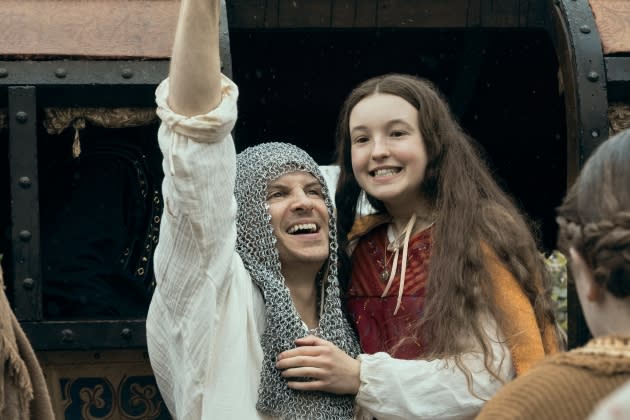Toronto Review: Lena Dunham’s ‘Catherine Called Birdy’
- Oops!Something went wrong.Please try again later.

Lena Dunham directs the Medieval comedic drama Catherine Called Birdy. The film is an adaptation of the book by the same name by Karen Kushman and stars Bella Ramsey, Andrew Scott, and Billie Piper.
A Catherine Called Birdy begins toward the end of the 13th century, and this is where the exposition begins. Catherine (Bella Ramsey) describes her life, friends, and family. Her father, Sir Rollo (Andrew Scott), and mother, Lady Aislinn (Billie Piper) of Stonebridge, have three children and one on the way. Her older brothers follow different paths. Edward (Archie Renaux) is a monk, and Robert (Dean-Charles Chapman) wants to be a knight. Catherine’s relationship with her parents is a strained one. She’s a 14-year-old girl who plays by her own rules, likes to break the law, and get dirty. Her mother wants her to be more ladylike, while her father is counting down the days until he can marry her off to the highest bidder.
More from Deadline
Toronto Review: Bess Wohl Film 'Baby Ruby' Starring Noemie Merlant And Kit Harrington
TIFF Deal Logjam Loosening? 'The Blackening' Scares Up Three WW Offers For Horror-Comedy
The family is going broke, so Rollo hopes she can find a wealthy suitor soon. Several suitors approach Stonebridge Manor and try to woo the young girl, but she’s having none of it. Catherine botches every attempt until she is forced to accept Shaggy Beard, a decrepit older man’s marriage proposal as her parents count down the days until she must leave the manner with her new husband, Catherine begins to contemplate what it means to be a woman and why women and young girls are forced to keep up with such toxic and patriarchal traditions.
Catherine Called Birdy reminds me of Kelly Fremon Craig’s 2016 film Edge of Seventeen, set in the middle ages. Catherine is as stubborn, annoying, and selfish as any teenager. However, her rebellious attitude toward marrying a man in his 60’s is justified. Cushman’s novel is a bit more serious in tone, so Dunham took a huge risk in making this film a more comedic venture. The gamble paid off because who could sit through a dark movie about child marriage? And no, Dunham isn’t mocking or making a joke of the topic but using humor as a coping mechanism for Catherine and the audience.
While the middle of the film is the weakest part, Kave Quinn’s production design and costumes by Julian Day are the top-quality. It is such a vast world and could have quickly sunk into low-budget territory, but their work elevates the visuals, which is aided by Laurie Rose’s cinematography. Medieval landscapes are drab, overcast, and dirty, and the camera work matches that aesthetic.
As Catherine moves through the world on her way to womanhood, she learns valuable lessons about selflessness, love, and acceptance. She wants to make everyone else’s lives miserable because the idea of leaving all that you know to be with someone you don’t love is too much to bear, so why not let others feel that pain? The book has a very different ending than the movie, which was a smart move because at least the character gets to keep their autonomy. The book is bleak, but Dunham goes with a more hopeful, inspired conclusion, and the young girl learns the biggest lesson: just because you’re unhappy doesn’t mean you can’t be happy for others.
Best of Deadline
NFL 2022 Schedule: Primetime TV Games, Thanksgiving Menu, Christmas Tripleheader & More
The Queen Onscreen: 15 Actresses (And Actors) Who've Played Elizabeth II In Film And On TV
'Blonde' Premiere Photo Gallery: Ana de Armas Channels Marilyn Monroe At Venice Film Festival
Sign up for Deadline's Newsletter. For the latest news, follow us on Facebook, Twitter, and Instagram.

